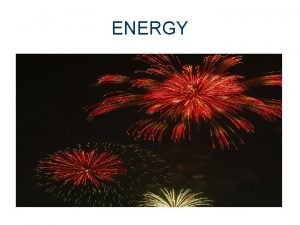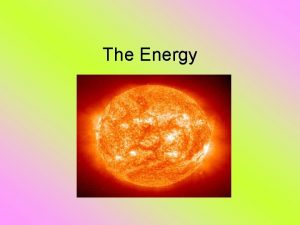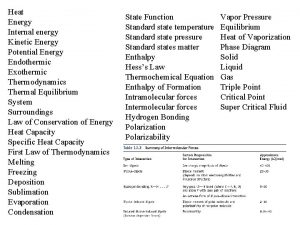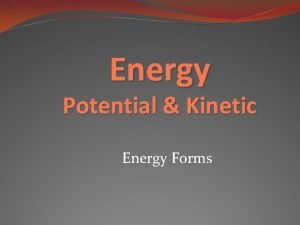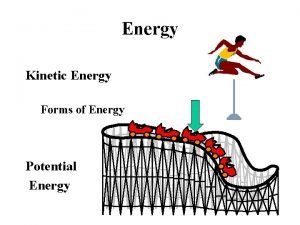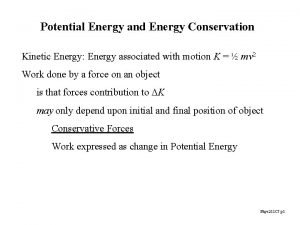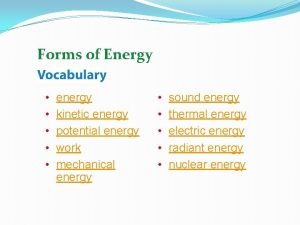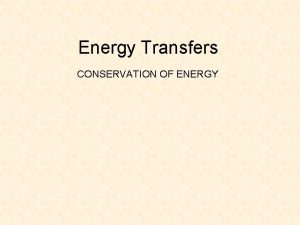Energy Systems What are energy systems for What










- Slides: 10


Energy Systems What are energy systems for? What is ATP? ATP is stored in the………….

ENERGY SYSTEMS Energy for muscular activity and other biological work comes from the breakdown of adenosine triphosphate (ATP). ATP loses one phosphate molecule and breaks down to Adenosine diphosphate. Since the store for ATP is limited, the body must regenerate its ATP as quickly as it is broken down. This regeneration connects the ADP and Pi together again to create ATP once more. This regenerating of ATP is done by the breakdown of fuel reserves. There are three energy systems for this 1. ATP-PC system 2. Lactic acid system 3. Oxygen (or aerobic ) system

The ATP-CP System The ATP- PC system uses a chemical fuel reserve, Creatine Phosphate, which is stored in the muscle. This process is anaerobic meaning it does not require the use of oxygen for it to work. CP is broken down into Creatine and Phosphate and the energy released from the breakdown is used to combine ADP and Pi to produce ATP. The supply of CP is limited and can only be used effectively for 10 to 20 seconds. When sufficient oxygen is available CP is regenerated ready to use again if needed.

The Lactic Acid System The lactic acid system uses the anaerobic breakdown of glycogen. Carbohydrate is stored in the body as glycogen (in the liver and in muscles). This process does not require oxygen. From the break down of glycogen we get a biproduct called pyruvic acid. At this stage the pyruvic can follow two courses of action. In the first if insufficient oxygen is available for further breakdown the pyruvic acid becomes lactic acid and is stored until sufficient oxygen is present and it then becomes pyruvic acid again and begins its aerobic breakdown.

The Aerobic System The Aerobic system produces its energy by utilising oxygen. It is performed through a series of chemical reactions known as the Krebs Cycle. Here we have the continued breakdown of glycogen from when it becomes pyruvic acid and enters the mitochondria. Fats (and in extreme circumstances proteins) are also broken down here as they can only be broken down aerobically. The results are the regeneration of ATP molecules and the production of by-products - water and carbon dioxide.

Summary of Energy Systems ATP-CP System Lactic Acid System Aerobic System Anaerobic Very rapid Chemical: CP Anaerobic Rapid Food: glycogen Very limited ATP Muscular stores limited Explosive, sprint 100 m Limited ATP Lactic Acid causes fatigue 1 to 3 min duration 400 m Aerobic Slow Food: CHO, Fat, Protein Unlimited ATP No fatiguing by-products Endurance Marathon

WHAT HAPPENS TO OUR BODY IN EXERCISE? Breathing rate gets deeper and faster: This is because the working muscle need more oxygen to function. By breathing faster and deeper more oxygen is getting into the lungs. From here oxygen then enters the blood and is then pumped by the heart around the body to the working muscles. Heart Rate Increases: The heart pumps blood and oxygen in the blood around the body. When the body and the muscles in particular need more oxygen the heart pumps faster to get more oxygen to the muscles.

THE BODIES RESPONSE TO EXERCISE Fill out the following table: FUNCTION DESCRIPTION inc OR decr Amount HEART RATE 70 bpm-average PERSPIRATION Up to 1 -litre in exercise RESPIRATION RATE Up to 40 -50 breaths during exercise STROKE VOLUME 70 -80 mls at rest TIDAL VOLUME ½ l at rest and 2. 5 l during exercise CARDIAC OUTPUT 4 -6 l/min rest Reason

THINGS TO THINK ABOUT: There are many physiological changes in the body at exercise What makes it difficult to sprint as fast as you can for more than one minute? Write a detailed answer in paragraph form.
 Mikael ferm
Mikael ferm Kontinuitetshantering i praktiken
Kontinuitetshantering i praktiken Novell typiska drag
Novell typiska drag Nationell inriktning för artificiell intelligens
Nationell inriktning för artificiell intelligens Returpilarna
Returpilarna Varför kallas perioden 1918-1939 för mellankrigstiden
Varför kallas perioden 1918-1939 för mellankrigstiden En lathund för arbete med kontinuitetshantering
En lathund för arbete med kontinuitetshantering Adressändring ideell förening
Adressändring ideell förening Personlig tidbok fylla i
Personlig tidbok fylla i Anatomi organ reproduksi
Anatomi organ reproduksi Vad är densitet
Vad är densitet












